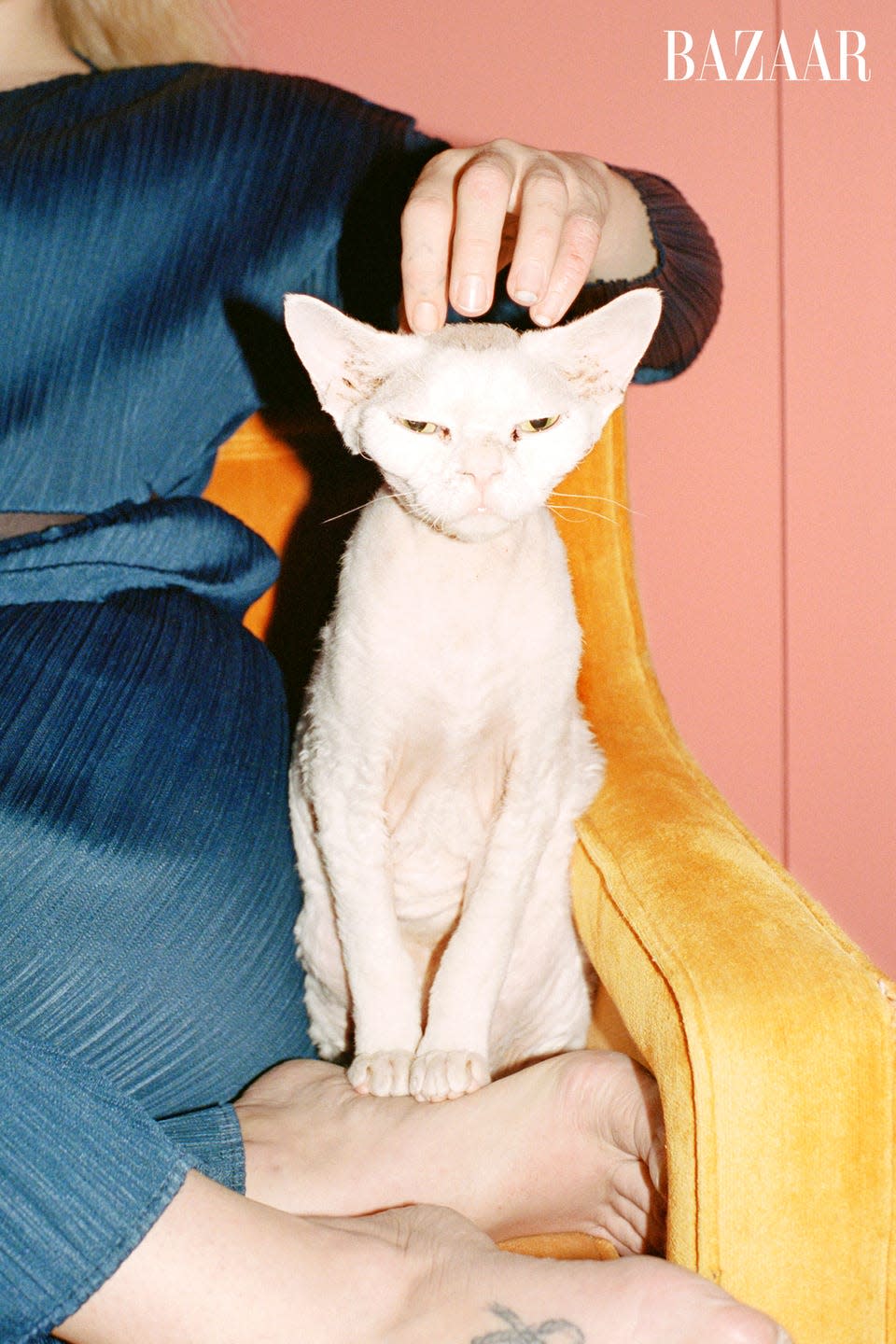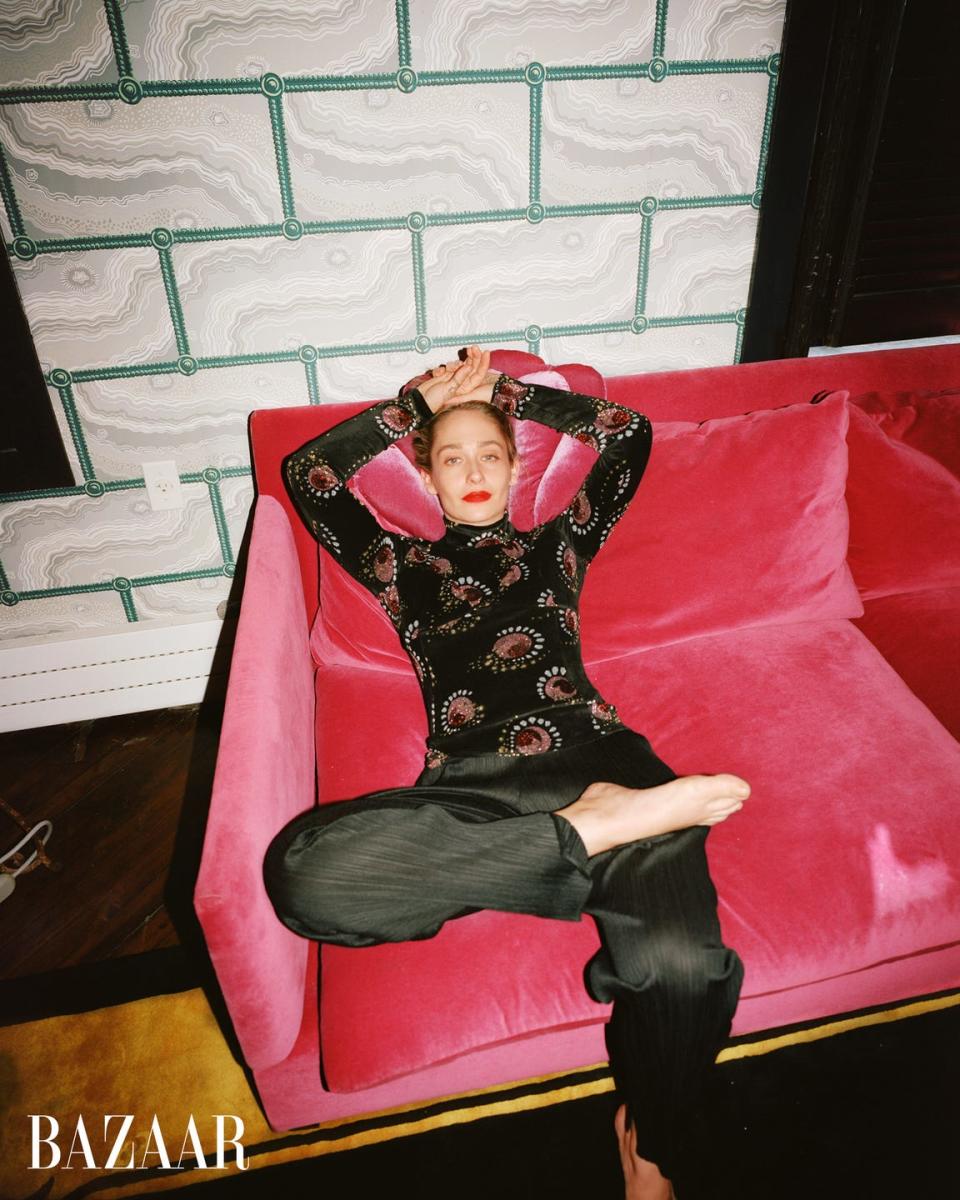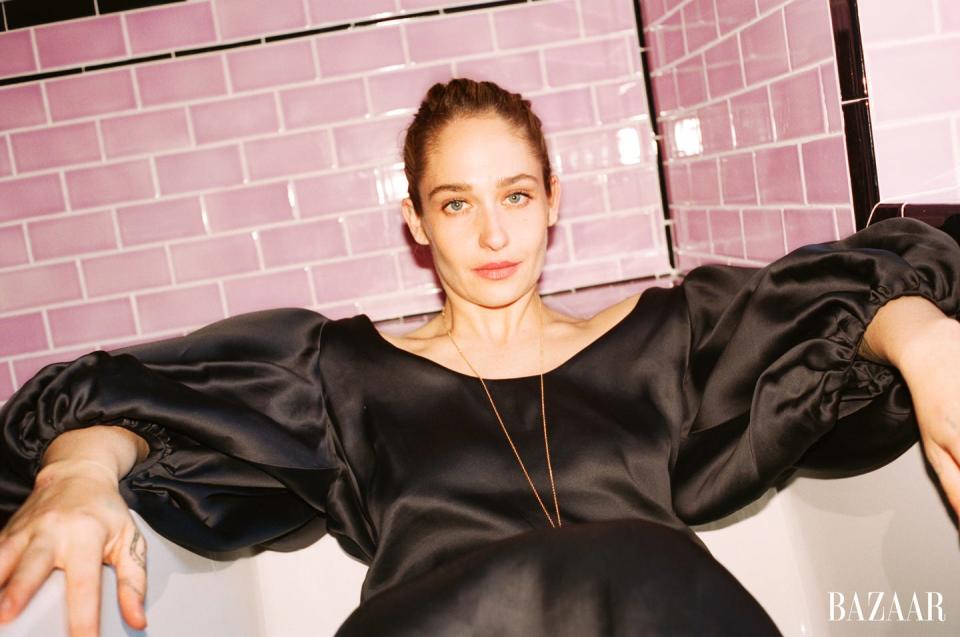Jemima Kirke Is Finished Playing Herself

“I hesitate to make this public,” Jemima Kirke tells me as we sit on her rustic back porch, shaded from the sun and listening to her two hairless cats meow for attention from behind the closed screen door. I lean forward. Is she going to confess something shocking about her work, her life, her loves?
Well, sort of: “My absolute favorite pre-code movies are Three on a Match and Blonde Venus,” she says, an American Spirit cigarette in her hand, a half-drunk smoothie on the table. “They’re my movies. I invented them.”
Kirke’s Old Hollywood secrets have to be shouted over the sounds of construction happening next door to her South Brooklyn home, where she’s lived with her two children for the last five years. The exaggeration is earned; she’s saying that these movies mean so much to her, they feel precious. The actress and painter, who turned 37 just a few days before we meet, can recount the thrillingly convoluted plot of Blonde Venus with the sort of vivid animation found most often when describing true love, and what is romance if not the claim that you belong to someone and that someone belongs to you?

In the 1932 film, Marlene Dietrich is a dancer and lounge singer doing whatever it takes to support her young son and sick husband—including getting involved with a wealthy patron played by Cary Grant. It’s a glamorous version of a classic tale about duty and sacrifice, art and romance. Throughout our afternoon together, we return to these same themes and to the rare films that feature mothers trying to live on their own terms. “I relate to this story, big-time,” Kirke admits. “That’s probably why I love it so much.”
Listening to Kirke talk about her devotion to the movies made in the years before the Hays Code enforced a strict version of Hollywood morality, relegating much actual human behavior off-screen, I’m realizing a very specific error I’ve made. Like so many people, I first began watching Kirke as Jessa on Girls, Lena Dunham’s career-defining show for HBO. A naturalistic satire of a well-defined but narrow millennial demographic, Girls almost immediately developed a reputation that was bigger than its actual influence. Critics and audiences alike were quick to reference it as a documentary and read the performances as autobiography.
Kirke, we were told, was cast as a version of herself that Dunham remembered from when they were friends in high school. (She appeared in Dunham’s first film, Tiny Furniture, in a similar role.) Dressed in a wardrobe of wide-brimmed hats, long, flowing sleeves, and skirts, she was always pulling her possessions out of suitcases as she bounced from apartment to apartment, continent to continent. The subtle yet unmistakable British clip of her voice (Kirke lived in England until she was 10, when her family moved to New York) gave her character’s sometimes-harsh dialogue a slow, dreamy depth.
The role that she played in the Girls quartet was so specific to a personality type, and yet it was vividly true to life. Not everyone knows a Jessa, but everyone has one friend you can’t take your eyes off of.
This week, Hulu premieres Lenny Abrahamson’s second adaptation of a Sally Rooney novel, Conversations With Friends, the much-buzzed-about follow-up to his critically acclaimed and painfully sexy adaptation of Normal People. Kirke plays a high-profile role: Melissa, the celebrated essayist who, for reasons that even she can’t seem to explain, invites protagonist Frances (Alison Oliver) and her ex-girlfriend/current best friend, Bobbi (Sasha Lane), into her home for dinner, her work as a writer, and, eventually, her marriage to Nick (Joe Alwyn).
Conversations With Friends is told from Frances’s point of view; this is a classic coming-of-age story about a young writer learning that a broken heart, like youth, comes with its own power. But it is also, in its own way, a coming-of-age for Melissa.
In Kirke’s performance, we see how her life has led to this moment. She has learned how her flowers should be cut, how her career should be managed, how a fish should be cooked for dinner. She can make an invitation to sit sound like a challenge and a request to get a lemon sound like a dare. More than beautiful, she is formidable. Frances and Bobbi appear, at different times and for very different reasons, to be unsure whether they want to love her, hate her, or be her.
Kirke is brilliantly cast as Melissa. Neither an object of affection nor a villain to be defeated, she is simply a person who wants a whole life—one with struggles and comforts, closeness and space. One scene toward the end of the show in particular encapsulates these warring impulses. In a confrontational conversation verging on an argument with Frances, the person she knows is having an affair with her husband, she holds her phone away from her ear and inhales like someone preparing to go underwater. Then she asks the younger woman if she’s okay.
Kirke is, of course, nothing like the characters she plays. As I sit on her porch, looking back through the kitchen window, I realize she’s not the kind of witchy Stevie Nicks blonde that Jessa was; she’s modeling herself after a very different archetype for women artists.

Inside the house, her children’s sketches are propped against the walls, and every surface is covered with the kind of small objects you just know have been gathered over a lifetime. But there’s also a framed photograph of Dietrich propped up by her dining table, and a ray of sunshine picks out a print of Marilyn Monroe hanging over her record player. Her living-room walls are dark, but the furniture is bright, including a plush magenta couch that sits in front of a mounted television screen—the perfect space for staying in and watching movies for love, fun, and research. Acting, for her, isn’t an accident; it’s a craft, a profession, and a way to pay the bills.
“That happens a lot in Hollywood, I think,” she says. “You’re like, Is this really what I want to do with my life? Just play a version of myself? And that can be great, but can you do it again? If it was just something you can do innately, how fulfilling is that as career? If you’re not doing something with your skill, it’s all about who you are.”
•
Kirke’s career since Girls has been steadily productive, a mix of roles that suit her style and challenge her sensibilities. She was raised by her mother, Lorraine Kirke, the owner of legendary New York vintage store Geminola, and her father, Simon Kirke, the drummer for bands such as Bad Company, and her entire family is made up of overlapping talents. (Her sister Lola Kirke is an actress and singer, and her other sister, Domino, is a singer, actress, and doula.)
Since Kirke was an artist who received her bachelor’s of fine arts in painting from Rhode Island School of Design in 2008, acting was a surprising turn for her career, and celebrity perhaps even more so. A mother to first her daughter, Rafaella, at 25 and then her son, Memphis, at 27, Kirke has been divorced for about five years and talks openly about finding the balance between supporting a family and spending time with them.
“I know there are single mothers who are actors,” she says, “but I just don’t know them. There’s sort of no way to do it harmoniously. It sucks as a parent and it sucks as actor, because when you’re not shooting, you are still supposed to be doing your homework— learning your lines and thinking and practicing.”

She is selective about her roles as a result, which could be the reason she says people sometimes assume her last substantial job was the finale of Girls. (“This is the other thing that I get a lot,” Kirke says with a bit of an eyeroll. “People saying, ‘Wow, you haven’t done anything since Girls.’ I’m like, are you kidding me?”) But that selectiveness is indicative of Kirke’s commitment to her career as both an artistic practice and a job. She had initially turned down the request to audition for Conversations, ready to take a break after filming Sex Education.
In the Netflix comedy, she plays Hope, the new and supposedly cool young principal of the local high school who slowly reveals herself to be an authoritative nightmare. As the villain who must be thwarted by the teenage heroes of the show, she gives a deeply funny performance. But working on location takes its toll, and she was most focused on being home with her children.
“When I get back from shooting, I want to make up for lost time,” she explains. But she read one scene of a Conversations script that made her reconsider. “I thought, This character is nuanced in a way I haven’t had the opportunity to do very often,” Kirke says of Melissa. “She felt like less of archetype.”


On set, Kirke worked closely with Sasha Lane, talking about the evolution of their characters’ relationship, which largely happens off-screen or in the background of the affair Frances has with Nick. “I have an affinity with Sasha because we started in similar ways,” she says. “No acting background, which is a really vulnerable position for a performer. You’re being asked to play yourself—not an easy thing if you don’t have the skills.”
Lane was notably cast as the lead in American Honey when director Andrea Arnold saw her on a Florida beach, and since that breakout performance she has also distinguished herself as a performer with a captivating honesty. As Bobbi, her style of conversation is funny and brutal, cutting through dinner-party politeness to get to the quick.
On the phone, Lane is similarly generous and direct in her observations, praising Kirke for her work on-screen as much as for her openness as a colleague. “Jemima is just highly intriguing to me,” Lane says. “She was very much her own person, and she’s very vocal about how to do a scene. We talked a lot about why our characters are even hanging out in the first place. She puts a lot of detail into everything, even the way she would pick up a coffee mug. She says it’s because of Lenny, but I think that’s also her. That’s her way of finding joy to each take, to each scene.”

Rooney’s writing has a cultural cachet not unlike what Dunham’s once had. The influence of her first three novels is often read as a gesture toward understanding an entire generation; critics and readers sometimes seem to be turning her expertly crafted fictions upside down in the search of some all-encompassing truth. “I’ve made that comparison in my head before,” Kirke says when I ask her about the connection. “They’re two young women writers who dare to have a point of view. And of course, their point of view is theirs. No one can be asked to speak for everyone, and if they did, everyone would be angry—rightly so. The fact is, is that Lena grew up with a lot of rich, White artists, so that is going to be her story.”
“Sometimes, I think people base a story’s worth off of how realistic it is,” Kirke continues, “and I don’t think anything has to be realistic. I think it has to connect to the viewer. Sometimes that means realism, and sometimes that doesn’t.”
Rooney tells stories about highly verbal young people at a moment when they are at a loss for words. Undone by wanting, they find that vocabulary and theory are useless against feeling. “I think there could have been a whole other series about Melissa’s marriage,” says Kirke, describing the work she did to understand her character. Her art has touched on these themes before; one show of her paintings was a series of portraits of women in their wedding dresses, some recently married and others recently divorced.
“What’s interesting about this is, as nuanced as she is, as modern and empowered and successful as she is,” Kirke continues, “she also succumbs to the sort of antiquated rules of marriage.” In this description, the adaptation of Rooney’s work starts to sound related to the same old movies Kirke loves—the not-so-subtle forces of desire up against unknowable subtexts, emotional obligations, and resting on deeply felt but precariously balanced loves.

Since Girls, Kirke has explored her own style in a way that seems to almost always suggest satire, a private joke between what she sees and what she says. “Observing current culture—not in any conscious way—is definitely where my sense of humor comes from. I make fun of people in my head all the time, myself included,” like the exaggerated version of herself she played on an episode of High Maintenance in 2019, making fun of the personalities that create that high-stress, low-stakes energy of a film set.
Kirke, like all people who know how to tell a good joke, takes life seriously. She has an affinity for banter and an aversion to bullshit. On her Instagram, for example, she has pinned a collection of stories called “Arguments” where she spars with judgmental commenters.
But though her candor remains, Kirke has also become more guarded than she once was, a fact that she freely admits to. Concise quips in captions and pull quotes for magazine stories can go only so far, and it has not escaped Kirke’s attention that the topics in need of the most nuance are often happening on platforms that prize abbreviations over dialogue, conclusions over discussions. “I do feel like we’re having a conversation,” she says, gesturing to my pair of recorders and notebook, “but we both know we’re not really.”
Before we spoke, I had watched as photographer Lorenz Schmidl took the shots accompanying this article. Kirke’s red lipstick was done, her hair up. During a short break, I caught a glimpse of her eating peanut butter off a knife in her kitchen. If the lipstick smudged, it was impossible to notice.

Often a person’s character can show in the smallest signs—the tells that an actress as sensitive as Kirke might have spent decades developing so that they can appear effortless when observed. When writing about Kirke’s favorite movie, the critic Molly Haskell once said that to separate Dietrich’s past from her performances was not the point. Dietrich brought herself to her parts, and the costumes were “more than cosmetic. They were the visual equivalent of words, of layers of self, of the autobiography she carried with her, partially revealed.”
This, too, is why Kirke can make any lens feel like a candid camera. Her work values honesty, which is not exactly the same thing as valuing reality. A thing doesn’t have to be real to feel true. She tells me a story about a recent day at home: Her son, nine, saw that her birthday was hard for her, and as a gift he made a book of coupons for her to redeem. “He was like, We can go to the museum, and we can maybe watch TCM, which is my favorite channel,” she shares.
It’s a small story of such sweetness, pure and rich in love, even though—we laugh a little at this part—she admits she would have happily skipped the museum and settled instead for an earlier bedtime. That will stay, for now, another behind-the-scenes confession. Reality is for the times when no one is watching.
Hair: Seiji Yamada
Makeup: Genevieve Herr
You Might Also Like


